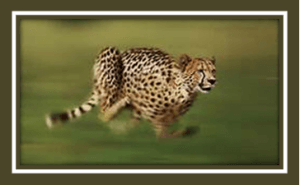African cheetah populations are small and fragmented. From Pieter’s Blog at LionAid.org, a report on the illegal trade of cheetahs and their “uncertain future.”
LIONAID: A recent poster by the Rangewide Conservation Program for Cheetahs and African Wild Dogs (RWCP) and the Cheetah Conservation Fund (CCF) presented at the recent Symposium on International Wildlife Trafficking has some very worrying statistics on the illegal trade of live cheetahs and cheetah products.
The organizations estimate that about 10,000 cheetahs remain in the wild in Africa, many in small, scattered populations with an uncertain future. Most of those wild cheetahs occur in Namibia, and most of those on private land. Other organizations say about 7,500.
Let’s begin with the illegal trade in live cheetahs. The above organizations estimate 118 cheetahs (largely cubs) were involved in 2012-2013 alone. Forty of the cases were recorded from northeastern Africa, where there is a well-recorded smuggling route involving Somalia and Yemen as transit countries for a ready market in the United Arab Republic. There have also been cases of live cheetah smuggling in the Middle East itself, and also in southern Africa – perhaps to supply the captive cheetah breeding industry in South Africa.
Now let’s look at the “legal” trade in live cheetahs. Based on official CITES records, South Africa exported a total of 817 live cheetahs between 2002 and 2012 (records for 2012 are not yet complete). Major importing countries included UAE (130), China (101), Japan (79), Mexico (49) and, surprisingly the USA (110). Why the USA is importing that many live cheetahs is a mystery, but cheetahs do not breed well in captivity.
The other major exporting country for live cheetahs is the UAE. During that period they exported 77 animals – to Armenia (14), Great Britain (14) and France (10) among the leading importers. So the UAE is both a major importer and a major exporter of live cheetahs…
However, another major legal CITES export category of cheetahs is hunting trophies and these all derive from Namibia. The numbers are quite staggering. From 2002-2012 (again, the 2012 numbers are still being compiled) Namibia exported 1,219 cheetah trophies. Such trophies are likely to all be adult males, though such details are not available.
Major importing countries were Germany (318), France (145), Austria (119), Spain (79), Poland (57), Hungary (51) and Denmark (43). The USA does not allow cheetah trophy imports as cheetahs are a listed species on their Endangered Species Act. Why then does the European Union not prohibit imports?
How many cheetahs are there in Namibia to support such offtake? The CCF does not know but was working on it according to a report in 2012 . Informal estimates arrive at a total of “about 3,000”.
Let’s say there are 3,000 – 4,000 cheetahs in Namibia. What percentage are adult males? Let’s be generous and say 20% (the rest being females, subadults and cubs). That would mean 600-800 males in Namibia, being hunted at a rate of about 116 animals per year. How can this be in any way “sustainable”? CITES actually allows an export quota of 150 cheetahs annually – live, skins, trophies. This level of exports was negotiated by Namibia.
So overall, the picture looks very worrying for cheetahs. Involved in illegal cub smuggling is only one concern. It is also disturbing that so many cheetahs are involved in the “legal” trade – many to dubious destinations. And then, Namibia is supporting a highly contentious level of trophy hunting to say the least.
If cheetahs are going to be conserved, it seems that conservation plans are in considerable disarray. Agonizing over the illegal wildlife trade is not convincing when the legal trade is undermining and confusing conservation efforts. The CCF supports cheetah trophy hunting as a conservation measure but must surely need to convince the Namibian authorities to bring their export quotas well down from current levels.
Cheetah protection will demand carefully considered conservation measures. Right now it seems a formula bound to fail, and until proper assessments can be made there should be an immediate moratorium on all cheetah exports from Africa – live, skins and trophies.
Photo credit: http://bit.ly/1mirsmN and Steve Bloom Images


0 Comments